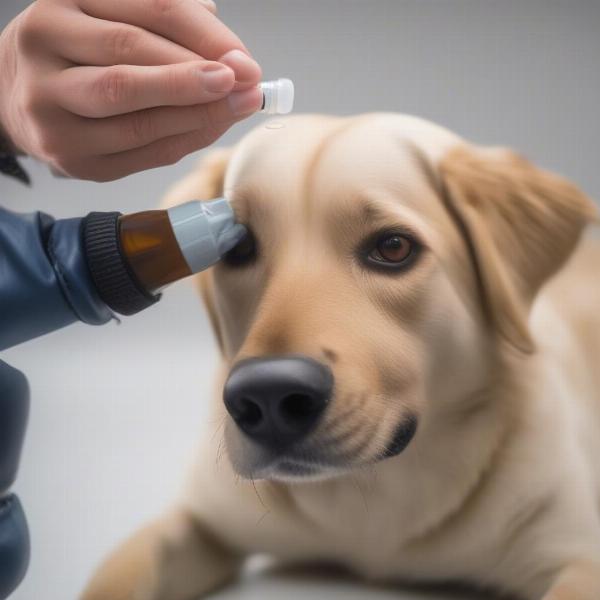Atropine eye drops for dogs are commonly used in veterinary ophthalmology, but it’s crucial to understand their purpose, administration, and potential side effects. This guide provides a detailed overview of atropine eye drops for dogs, covering everything from their uses and precautions to potential side effects and alternatives.
Understanding Atropine Eye Drops
Atropine belongs to a class of drugs called anticholinergics. It works by blocking the action of acetylcholine, a neurotransmitter that controls muscle contraction. In the eye, atropine dilates the pupil (mydriasis) and paralyzes the ciliary muscle (cycloplegia), preventing the eye from focusing.
 Administering Atropine Eye Drops to a Dog
Administering Atropine Eye Drops to a Dog
Why Are Atropine Eye Drops Used in Dogs?
Veterinarians prescribe atropine eye drops for a variety of reasons, including:
- Diagnostic Purposes: Dilating the pupil allows for a better examination of the internal structures of the eye, such as the retina and optic nerve. This is crucial for diagnosing conditions like cataracts, glaucoma, and uveitis.
- Therapeutic Treatment: Atropine can help reduce pain and inflammation associated with uveitis (inflammation of the uvea), corneal ulcers, and other eye injuries. It can also prevent the formation of adhesions within the eye.
- Pre- and Post-Surgery: Atropine is often used before and after eye surgery to facilitate procedures and prevent complications.
Administering Atropine Eye Drops: A Step-by-Step Guide
It’s essential to follow your veterinarian’s instructions carefully when administering atropine eye drops. Here’s a general guide:
- Wash your hands thoroughly.
- Gently restrain your dog. It may be helpful to have someone assist you.
- Tilt your dog’s head slightly back.
- Pull down the lower eyelid to form a small pouch.
- Hold the dropper close to the eye without touching it.
- Squeeze the prescribed number of drops into the pouch.
- Close the eye gently for a few seconds to distribute the medication.
- Praise and reward your dog.
Potential Side Effects and Precautions
While generally safe, atropine eye drops can cause some side effects, such as:
- Temporary blurred vision: This is due to the dilation of the pupil and paralysis of the ciliary muscle.
- Increased sensitivity to light (photophobia): Due to the dilated pupil, more light enters the eye.
- Dry eyes: Atropine can reduce tear production.
- Increased heart rate: In rare cases, atropine can affect the heart rate.
It’s crucial to contact your veterinarian immediately if you notice any unusual symptoms after administering atropine eye drops. Avoid using atropine in dogs with glaucoma, certain heart conditions, or a known allergy to the medication.
Alternatives to Atropine
Several alternatives to atropine exist, including tropicamide and cyclopentolate. Your veterinarian will determine the most appropriate medication based on your dog’s specific condition and needs.
Conclusion
Atropine eye drops are a valuable tool in veterinary ophthalmology. Understanding their uses, administration, and potential side effects is crucial for ensuring your dog’s safety and well-being. Always consult with your veterinarian before administering any medication to your dog, including atropine eye drops.
FAQ
-
How long do the effects of atropine eye drops last in dogs? The effects can last for several hours to several days, depending on the concentration and individual dog.
-
Can I use human atropine eye drops on my dog? No, never use human medications on your dog without consulting your veterinarian. The concentrations can differ significantly, and human medications may contain ingredients that are toxic to dogs.
-
What should I do if my dog accidentally ingests atropine eye drops? Contact your veterinarian or a pet poison control center immediately.
-
Are there any long-term side effects of using atropine eye drops in dogs? Generally, no, but prolonged use can lead to dry eyes or other complications. Always follow your veterinarian’s recommendations regarding the duration of treatment.
-
Can atropine eye drops be used in pregnant or nursing dogs? Consult your veterinarian before using atropine in pregnant or nursing dogs.
-
What should I do if my dog’s eye becomes red or irritated after using atropine? Contact your veterinarian. This could be a sign of an allergic reaction or other complication.
-
Can I purchase atropine eye drops over-the-counter? No, atropine eye drops require a prescription from a veterinarian.
ILM Dog is a leading international pet website dedicated to providing expert advice on dog care and wellbeing. We cover a wide range of topics, from breed selection and health care to training, nutrition, grooming, and much more. Whether you’re a new dog owner or a seasoned expert, ILM Dog offers valuable resources and insights to help you provide the best possible care for your canine companion. For expert advice on dog health, breeds, training, nutrition, and more, contact us at [email protected] or call us at +44 20-3965-8624. ILM Dog is here to support you every step of the way on your dog ownership journey.